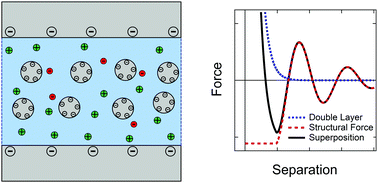Untangling superposed double layer and structural forces across confined nanoparticle suspensions†
Abstract
The description of forces across confined complex fluids still holds many challenges due to the possible overlap of different contributions. Here, an attempt is made to untangle the interaction between charged surfaces across nanoparticle suspensions. Interaction forces are measured using colloidal-probe atomic force microscopy. The experimental force profiles are considered as a superposition of double layer and structural forces. In order to independently describe the decay of the double layer force, the ionic strength of the suspension is determined by electrolytic conductivity measurements. Jellium approximation is used to define the impact of the fluid on screening the surface potential. There, the nanoparticles are considered homogeneously distributed across the fluid and screening is only carried out via the particles counterions and added salt. The structural force follows a damped oscillatory profile due to the layer-wise expulsion of the nanoparticles upon approach of both surfaces. The description of the oscillatory structural force is extended by a depletion layer next to the confining surfaces, with no nanoparticles present. The thickness of the depletion layer is related to the electrostatic repulsion of the charged nanoparticles from the like-charged surfaces. The results show that the total force profile is a superposition of independent force contributions without any mutual effects. Using this rather simple model describes the complete experimentally determined interaction force profiles very well from surface separations of a few hundred nanometres down to the surfaces being almost in contact.



 Please wait while we load your content...
Please wait while we load your content...